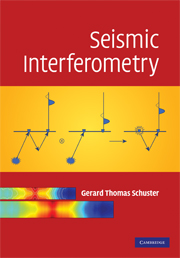Book contents
- Frontmatter
- Contents
- Preface
- 1 Introduction
- 2 Reciprocity equations of convolution and correlation types
- 3 VSP → SWP correlation transform
- 4 VSP → SSP correlation transform
- 5 VSP → SSP convolution transform
- 6 SSP → SSP correlation transform
- 7 VSP → VSP correlation transform
- 8 SSP → VSP → SWP transforms
- 9 Traveltime interferometry
- 10 Stochastic interferometry
- 11 Interferometric source estimation
- 12 Body wave earthquake interferometry
- References
- Index
4 - VSP → SSP correlation transform
Published online by Cambridge University Press: 15 October 2009
- Frontmatter
- Contents
- Preface
- 1 Introduction
- 2 Reciprocity equations of convolution and correlation types
- 3 VSP → SWP correlation transform
- 4 VSP → SSP correlation transform
- 5 VSP → SSP convolution transform
- 6 SSP → SSP correlation transform
- 7 VSP → VSP correlation transform
- 8 SSP → VSP → SWP transforms
- 9 Traveltime interferometry
- 10 Stochastic interferometry
- 11 Interferometric source estimation
- 12 Body wave earthquake interferometry
- References
- Index
Summary
This chapter presents the VSP → SSP correlation transform which maps vertical seismic profile data into virtual surface seismic profile traces. The benefits of this transform are that it eliminates well statics and the need to know the source or receiver position in the well, and it greatly extends the illumination of the subsurface compared to that provided by VSP primaries. Several synthetic and field data examples are presented that reinforce these claims. The drawback to this transform is that it converts VSP multiples to virtual SSP primaries, which can lead to a degradation of the signal-to-noise ratio in the presence of strong attenuation, deep imaging depths, and a limited aperture of receivers and sources.
VSP→SSP correlation transform
AVSP survey is depicted in Figure 4.1a, where 91 geophones are evenly deployed in the well from 0.1 km to a depth of 1.0 km and 260 sources are evenlydistributed on the surface between x = 0.3 km and x = 0.89 km. Figure 4.1b depicts a typical shot gather and, after directional median filtering (Yilmaz, 2001), Figures 4.1c–d show the shot gathers with only downgoing and upgoing waves, respectively. As illustrated by the “ghost” ray in Figure 4.1a, the downgoing arrivals are primarily ghost reflections from the free surface. Equations are now presented for transforming these VSP ghost arrivals into primaries recorded by a virtual SSP survey where both sources and receivers are just below the free surface.
Assume the Figure 4.2 VSP acquisition geometry for a free surface at S0 and an underlying acoustic medium of arbitrary velocity and constant density.
- Type
- Chapter
- Information
- Seismic Interferometry , pp. 86 - 108Publisher: Cambridge University PressPrint publication year: 2009



